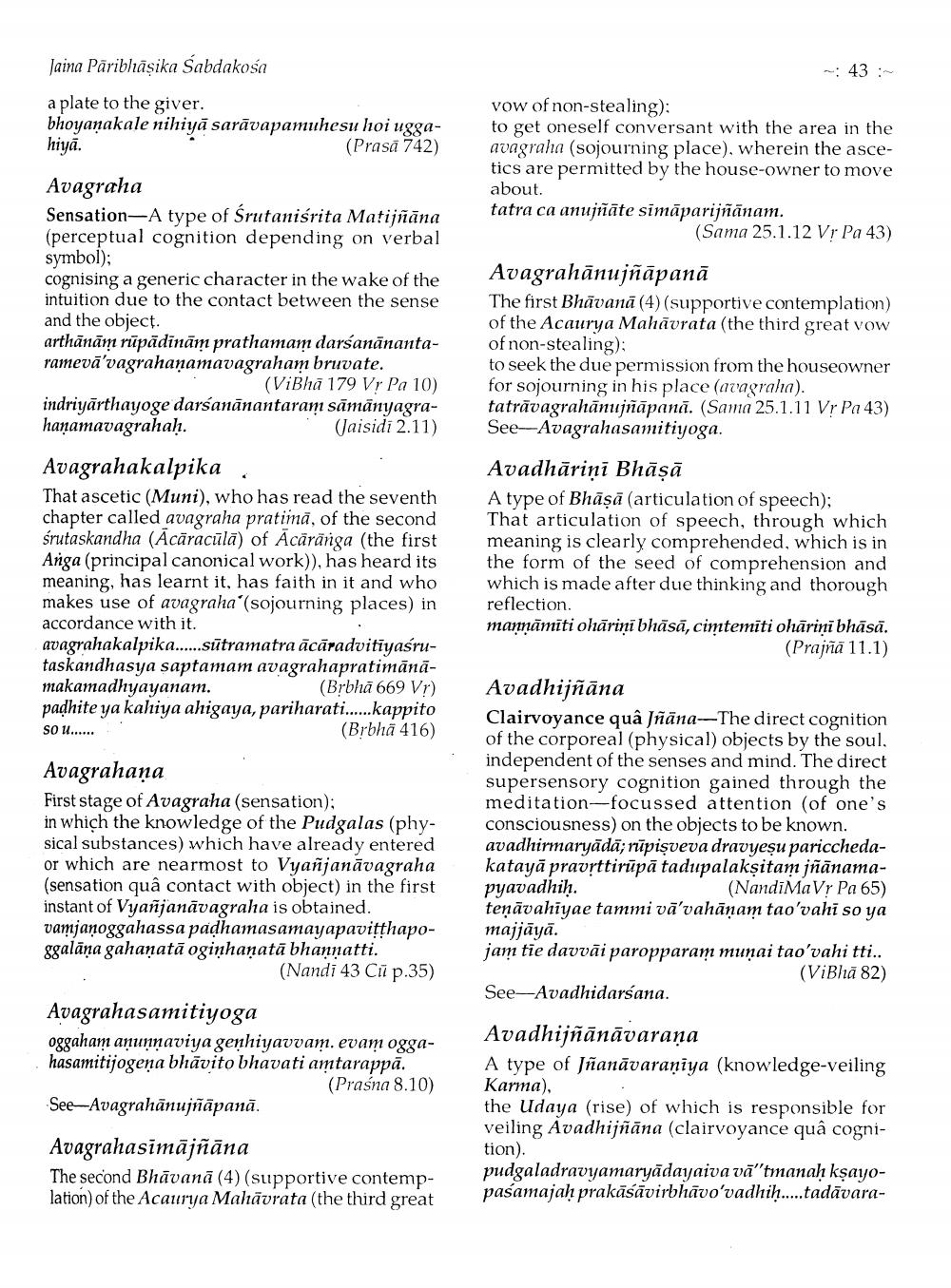________________
Jaina Pāribhāsika Sabdakośa
43:
a plate to the giver. bhoyanakale nihiyā sarāvapamuhesu hoi uggahiya.
(Prasā 742)
vow of non-stealing); to get oneself conversant with the area in the avagraha (sojourning place), wherein the ascetics are permitted by the house-owner to move about. tatra ca anujñāte simāparijñānam.
(Sama 25.1.12 Vr Pa 43)
Avagraha Sensation- A type of Śrutanisrita Matijñāna (perceptual cognition depending on verbal symbol); cognising a generic character in the wake of the intuition due to the contact between the sense and the object. arthānām rūpādinām prathamam darsanānantaramevā'vagrahanamavagraham bruvate.
(ViBhā 179 Vr Pa 10) indriyārthayoge darśanānantaram sāmānyagrahanamavagrahah.
(Jaisidi 2.11)
Avagrahānujñāpanā The first Bhāvanā (4) (supportive contemplation) of the Acaurya Mahāvrata (the third great vow of non-stealing); to seek the due permission from the houseowner for sojourning in his place (avagraha). tatrāvagrahānujñāpanā. (Sama 25.1.11 Vr Pa 43) See--Avagrahasamitiyoga.
Avagrahakalpika, That ascetic (Muni), who has read the seventh chapter called avagraha pratimă, of the second śrutaskandha (Ācāracūlā) of Ācāränga (the first Arga (principal canonical work)), has heard its meaning, has learnt it, has faith in it and who makes use of avagraha'(sojourning places) in accordance with it. avagrahakalpika......sūtramatra ācāradvitiyasrutaskandhasya saptamam avagrahapratimānāmakamadhyayanam.
(Brbhā 669 Vr) padhite ya kahiya ahigaya, pariharati.....kappito so u......
(Brbha 416)
Avadhāriņi Bhāṣā A type of Bhāṣā (articulation of speech); That articulation of speech, through which meaning is clearly comprehended, which is in the form of the seed of comprehension and which is made after due thinking and thorough reflection mannāmiti ohārini bhāsā, cimtemiti ohārini bhāsā.
(Prajna 11.1)
Avagrahaņa First stage of Avagraha (sensation); in which the knowledge of the Pudgalas (physical substances) which have already entered or which are nearmost to Vyañjanāvagraha (sensation quâ contact with object) in the first instant of Vyañjanāvagraha is obtained. vamjanoggahassa padhamasamayapavitthaposgalāņa gahanatā oginhaņatā bhannatti.
(Nandi 43 Cu p.35)
Avadhijñāna Clairvoyance quâ jñāna—The direct cognition of the corporeal (physical) objects by the soul. independent of the senses and mind. The direct supersensory cognition gained through the meditation-focussed attention (of one's consciousness) on the objects to be known. avadhirmaryādā; rūpişveva dravyeşu paricchedakatayā pravrttirūpā tadupalaksitam jñānamapyavadhiḥ.
(NandiMaVr Pa 65) teņāvahiyae tammi vā'vahāņam tao'vahi so ya majjāyā. jam tie davvāi paropparam munai tao'vahi tti..
(ViBhā 82) See-Avadhidarśana.
Avagrahasamitiyoga oggaham anunnaviya genhiyavvam. evam oggahasamitijogeņa bhāvito bhavati amtarappā.
(Prasna 8.10) See-Avagrahānujñāpanā.
Avadhijñānāvarana A type of Jñanāvaraniya (knowledge-veiling Karma), the Udaya (rise) of which is responsible for veiling Avadhijñāna (clairvoyance quâ cognition) pudgaladravyamaryādayaiva vā"tmanah kşayopašamajah prakāśāvirbhāvo'vadhiḥ.....tadāvara
Avagrahasimājñāna The second Bhāvanā (4) (supportive contemplation) of the Acaurya Mahāvrata (the third great




